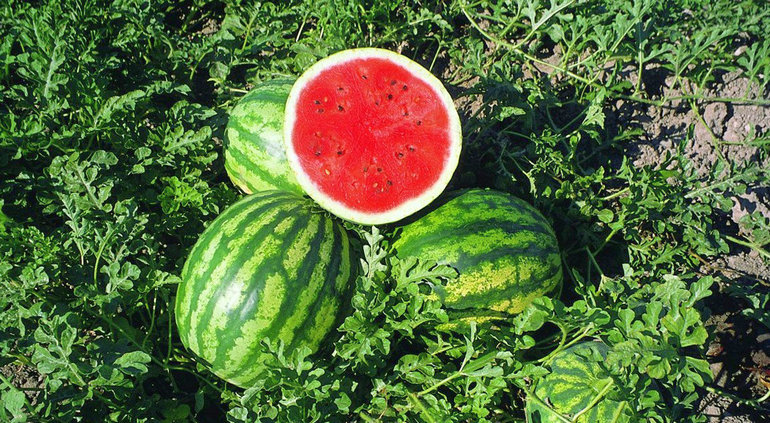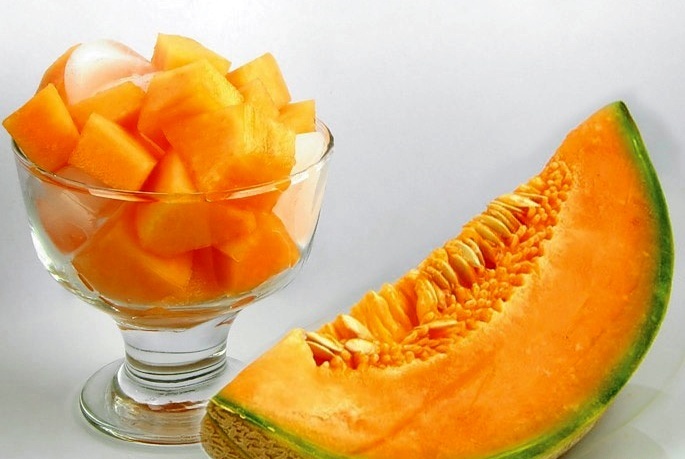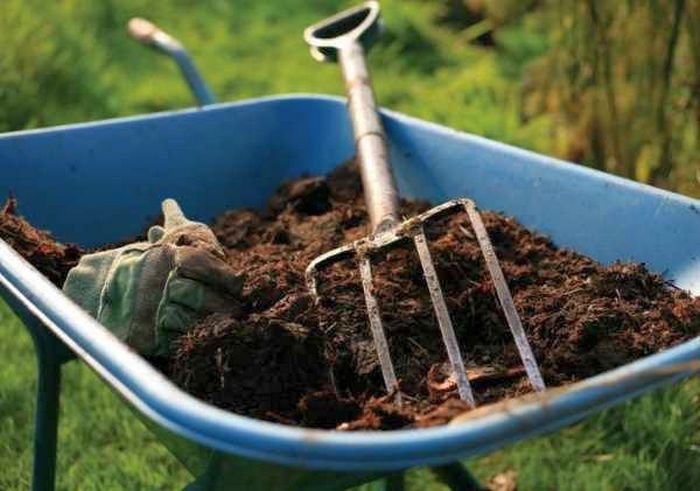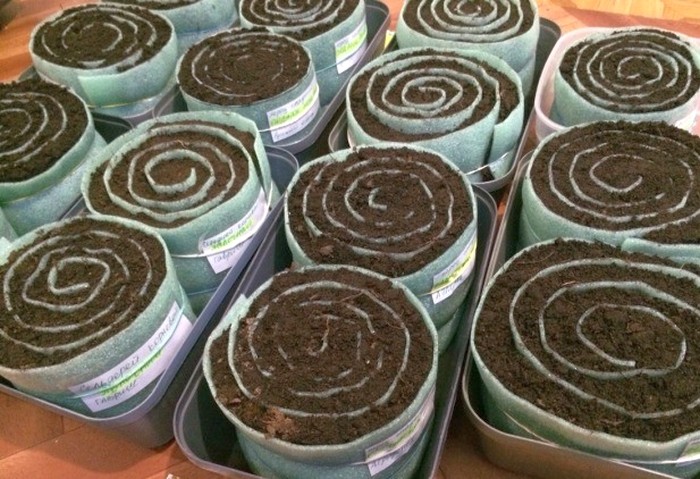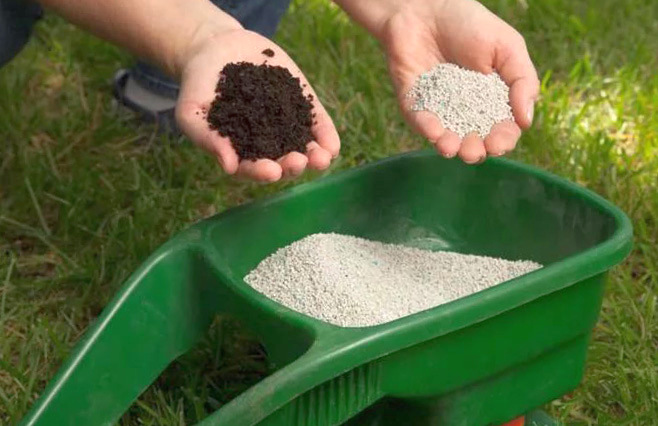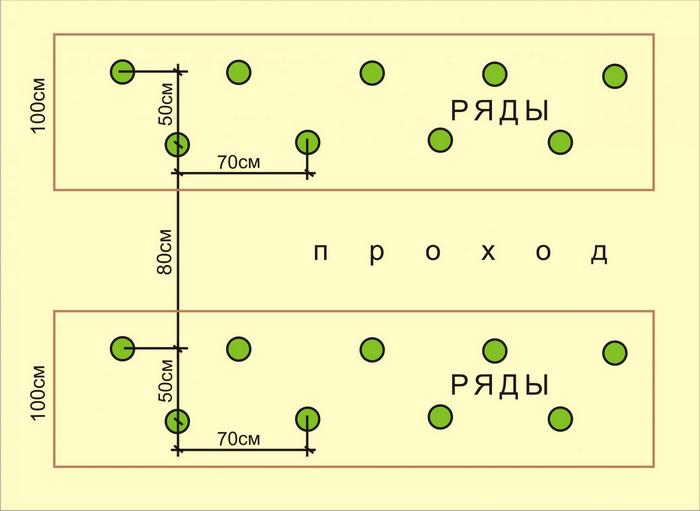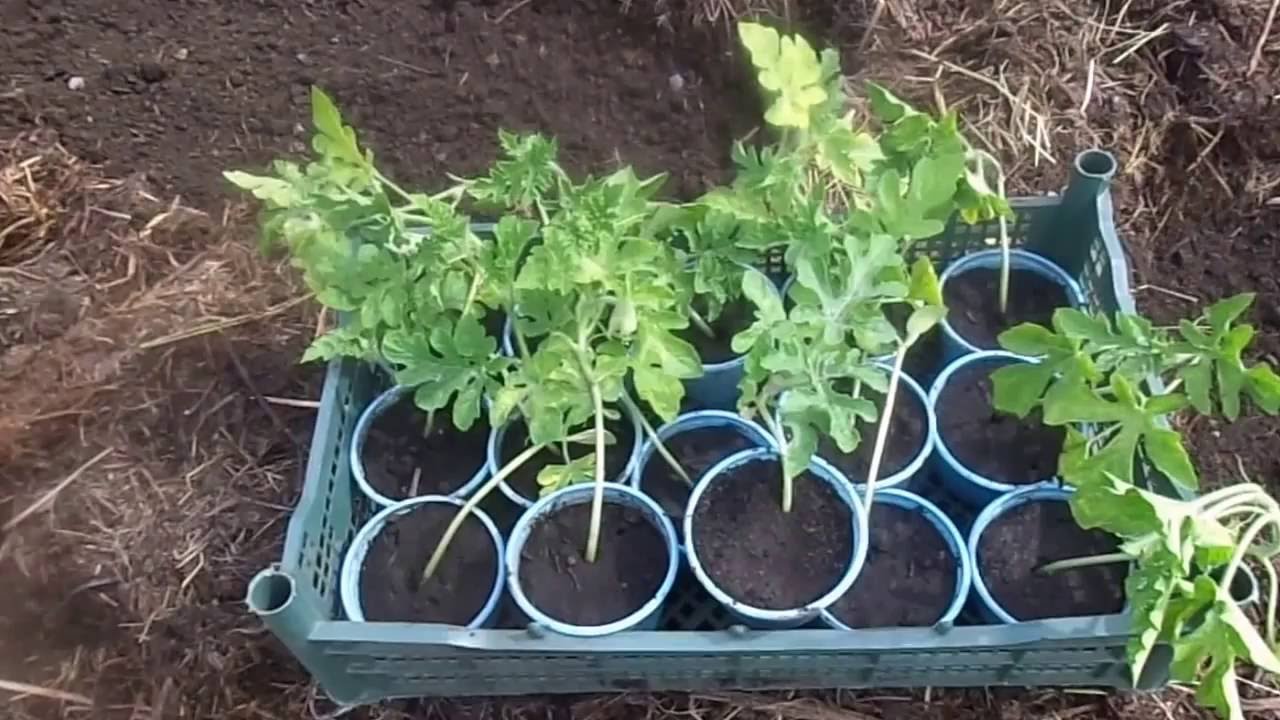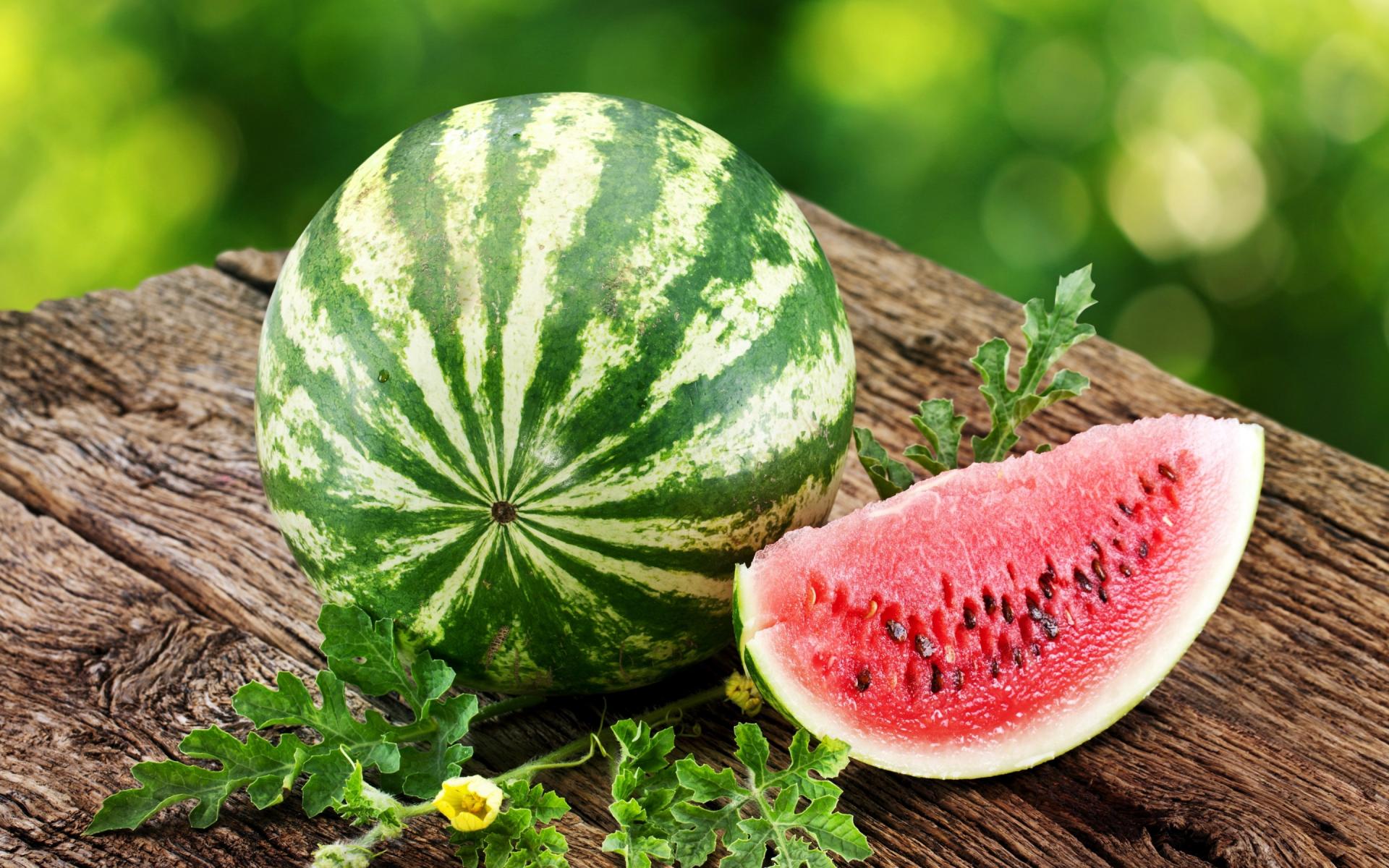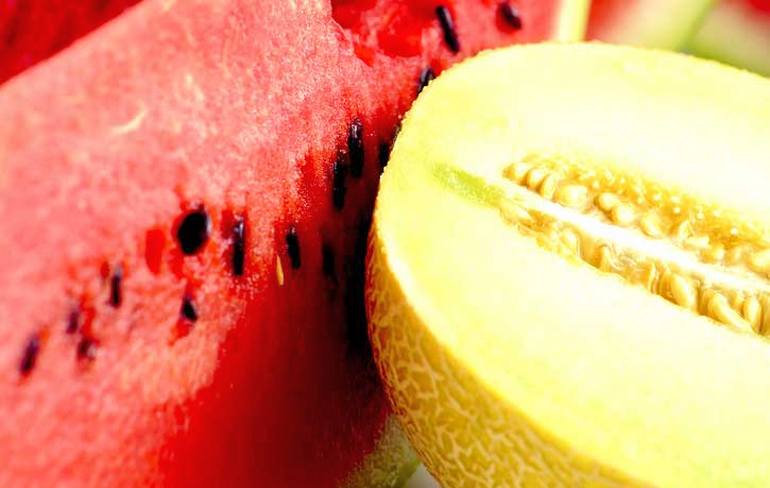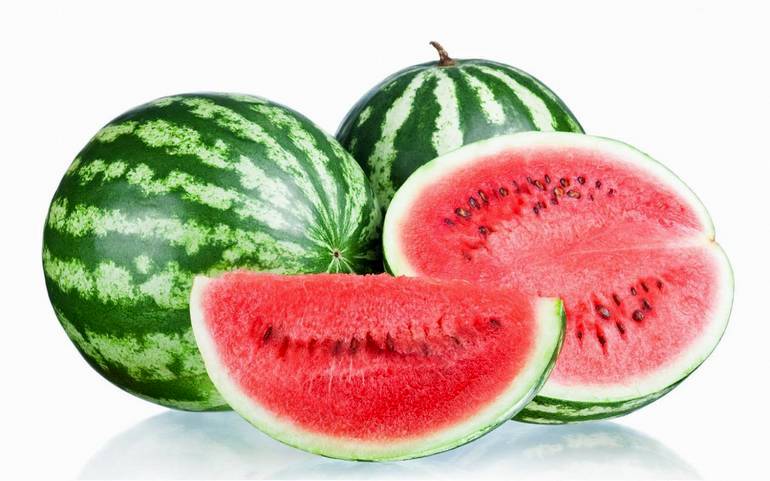Content:
Since watermelons and melons are mostly found in the south, in other areas, seedlings must first be grown and then transferred to the plot. Seedlings of watermelons and melons can be planted even in Siberia and the Urals, but you need to choose the right variety, follow the instructions for growing seedlings, make sure that the seedlings are healthy and plant seedlings in the ground on time.
Planting watermelons for seedlings
In the center of Russia, in the east or north, you need to buy seeds of early varieties so that you can harvest in 70–90 days. Since in the Moscow region seedlings are planted in the ground at the end of May, late-ripening varieties do not have time to ripen. And for Siberia and the Urals, it is better to choose varieties that withstand the cold climate well.
Watermelon varieties suitable for the center and north of Russia:
- Superearly Dutina - the record holder in terms of the appearance of fruits, ripens in 58-60 days. The plant is not large, has a small number of lashes, each up to 2 m in length. The watermelons are scarlet inside. The pulp is grainy, dense. Fruit weight 4–6 kg. Stored for about a month.
- Ultra-ripe- also a record holder, the fruits ripen in 65–75 days. Plants are easy to care for, they are not afraid of a drop in temperature. They are resistant to anthracnose and powdery mildew. Fruit weight 1.5-3 kg. The pulp tastes sweet, grainy and tender. Collect 2.1 kg from 1 m².
- Charleston Gray - bred in France, it can easily endure the harsh climate of Siberia. The culture is powerful, a large number of long lashes grow. Fruit weight up to 18 kg. Fruits are elongated in shape. The pulp is scarlet, very sweet. The variety is immune to disease. You can store the fruits for up to 1.5 months.
- Siberian lights - ripening period 78–95 days. The variety is resistant to fusarium. Fruit weight 1–2.4 kg. The pulp is sweet. It grows well in an open area, because it easily tolerates low temperatures.
- Twinkle- easy to grow, not afraid of cold weather. The variety is quite popular in Siberia. Fruits weighing about 2 kg. Watermelons have excellent taste.
- AstrakhanIs another well-known and popular variety that is not afraid of cold weather. The fruits are large, weighing up to 6 kg. They keep well.
- Photon - 82-105 days pass from the emergence of sprouts to the ripening of watermelons. Berry weight 3-6 kg. The pulp has an excellent dessert taste. The bushes are resistant to anthracnose.
- Siberian lights - 70–80 days pass from germination to berry picking. The bush is compact, lashes up to 2.5 m. The pulp of the berries is juicy, scarlet, sweet.
- Siberian - withstands cold Siberian climate well. Berry weight is about 5 kg. Fruit of a sweet dessert taste.
- Raspberry sweet - grows well both in Siberia and the Urals. Watermelons are small, weighing up to 1.5 kg. The pulp is sweet. Easy to care for.
Melon varieties that are suitable for the north and the Moscow region:
- «Sybarite's dream"- from emergence to harvesting, the harvest takes 50–55 days. Fruit weight 3 kg. It is pale yellow. The pulp is white, juicy, with a honey flavor. From 1 m² collect up to 20 kg. The fruits ripen until the very frost. The variety is very resistant to pest attacks.
- «Cappuccino"- 2–2.5 months pass from the first shoots to fruit ripening. The fruit is round or oval. Berry weight 0.8–1.5 kg. The pulp has an excellent dessert taste, contains 17% sugar. Up to 15 kg are harvested from the bush.
- «Cinderella"- the period from germination to berry ripening is about 2–2.5 months. Long lashes grow on the stem. The fruit is oval. Weight 1–2.5 kg. Remove about 10-15 berries from the bush.
- «Golden"- 72–87 days pass from germination to berry ripening. There are few lashes on the stem. The melon is round or oval. Fruit weight up to 2 kg. It tastes like honey. 25 tons are harvested from 1 hectare. Berries can be transported.
- «Sympathy"- fruits ripen in 100-108 days. Long lashes grow on the stem. Fruit weight 1.2–2 kg. The melon is oval. The pulp is sugary, very juicy. From 1 m² collect up to 0.7 kg.
Seed preparation
How to prepare watermelon and melon seeds for sowing:
- Make a composition of half a glass of water and half a teaspoon of salt. Add seeds.
- Throw out those that have floated to the surface, and select those that have fallen to the bottom of the glass, rinse in water, dry.
- Place the seeds for 2-3 hours in clean water 50-60 ° C.
- Then pour the seeds into a weak solution of potassium permanganate for half an hour.
- Make a solution of Epin (growth stimulant): 4-6 drops in half a glass of water. Place the seeds in the solution for 18-24 hours.
- Then pour the seeds into water and wait for them to hatch.
Preparation of land and tanks
To make a suitable soil, you need to mix 3 parts of humus, 1 part of turf. Another mixture - 6 parts of low-lying peat, 2 parts of sawdust and 1 part of humus. Humus is needed for the soil to contain many nutrients for growth.
Peat pots are available. Since peat is a natural substance, it also fertilizes the culture, the walls of the pot are porous, they easily allow moisture and oxygen to pass through, the roots can grow through the pots, they do not deform. When planting a plant in a pot of peat, the roots are not damaged, as when transplanted from plastic.
There is also a sowing method called "snail": the soil is poured onto a long strip made of various materials. This strip, together with the earth, is carefully rolled up like a roll.
Seed sowing dates
Cultivation of watermelon seedlings begins in late March or early April. If the seeds are sown later, the seedlings will not grow by the date of transplantation.
Planting and growing seedlings
How to plant seedlings in a "snail": the substrate for the laminate is cut into strips 9.5–6.5 cm wide. To cut, it is carefully rolled into a roll and fixed with tape; then a piece of the required width is cut off from the substrate, the adhesive tape is removed.
After that, moistened earth is poured onto the cut strip with a layer of 1–1.5 cm. Then 2 cm recede from the edge of the substrate and the seeds that have hatched are laid out on the ground. An indent of 10 cm is made between the seeds, but 2 seeds are placed at once. The seeds are pressed into the soil a little, then a strip from the substrate is twisted like a roll. You need to twist it tightly so that the seeds do not slide down. Fasten the roll with tape.
Now you need to put it so that the seeds are at the top. Now you need to add soil, put in a container, water abundantly. The first time it is watered from above, and then water is poured into the container. They put on a film, put it in a warm place.
How to plant watermelons and melons for seedlings in boxes: there should be an indent of 10–12 cm between the pits. First, drainage from expanded clay, broken brick should be poured onto the bottom. Pour the prepared soil into the container 2/3.
Better to sow seeds in peat cups or tablets. Place 2 seeds in each pot or tablet to a depth of 3-5 cm. When sprouts appear, choose the most powerful one, and carefully cut the weak one with scissors. You should not pull it out, otherwise the roots of the nearest seedling will be damaged. As a rule, the first shoots grow in 4-6 days.
Seedling care at home
Peat pots should be wrapped with stretch wrap.And if peat tablets are selected, place them in a container, cover with foil, put in a warm place.
Requirements:
- before the sprouts appear, the temperature should be 25-30 ° C;
- every day you need to air the plantings by lifting the film;
- be sure to moisten the ground from a spray bottle;
- when shoots appear, remove the film, reduce the temperature to 18 ° С at night and 20-25 ° С during the day;
- if the seeds are sown in a box, after the appearance of 2-3 true leaves, dive into separate pots. Further care consists of watering and fertilizing.
How to water
Watermelon and melon seedlings are often watered, but not abundantly. If the ground dries up, the seedlings can get sick. The same will happen with an excess of moisture.
How to fertilize
When the culture has 1 real leaf, you need to prepare a nutritional solution:
- 15 g superphosphate;
- 6 g of ammonium nitrate;
- 7 g potassium sulfate;
- 10 liters of water;
- 2.5 l mullein.
First, mix the water with the mullein, add mineral fertilizers, water the plants under the root, trying not to get on the foliage.
Fertilize the second time in 2 weeks.
Mistakes when growing seedlings
Seedlings of watermelons may die due to an excess of water, it provokes fusarium. This is also due to low temperatures. If signs of fusarium disease are found in the initial stage, diseased seedlings will have to be destroyed. With fusarium, the foliage turns yellow, and the roots begin to rot.
Be sure to follow these rules:
- spill the earth before planting with a solution of potassium permanganate, disinfect tools;
- it is impossible for the seedlings to stand in a draft;
- properly feed the sprouts.
Seedlings may have too long stems. This is due to insufficient lighting, so the seedlings need to be additionally illuminated with lamps. Daylight hours should be 12 hours.
Planting time for watermelon and melon seedlings
According to the lunar calendar, no operations with seedlings on the full moon can be performed. The second quarter of the waxing moon phase is well suited.
Seedlings love warmth, their roots need a temperature of up to 30 degrees, because of this, a culture is planted after warming up the soil by 15 cm.
The beds are dug up in the fall, and in March ash is scattered over the beds so that the snow melts. In April, you can spill the bed with hot water and cover it with a film, then the soil will warm up faster. The film warms up the soil, protects it from the growth of weeds, and preserves moisture.
It is best to plant seedlings on the site when they are 25-30 days old. In a greenhouse in Siberia and the Urals, you can plant seedlings from 1 to 10 June. Return frosts in Siberia stop by June 10, so bushes are planted in mid-June on the site. Also in the Pskov region.
To grow watermelons and melons in an open area in the Urals and Siberia, you need to build insulated beds. Dig a trench, pour sawdust, shavings or dry branches on the bottom. Then add manure, compost, fallen leaves with a layer of 40 cm and sprinkle with EM preparations (these are effective microorganisms, bacteria required by the soil). Then add the substrate by mixing 6 buckets of compost, 1 bucket of river sand, a little ash. When the manure is overheated, it will generate heat. It is better to plant seedlings in a checkerboard pattern, leave a distance of 1-1.5 m between the holes.
It is possible to grow heat-loving watermelons and melons in different regions. The main thing is to choose the right varieties, calculate the time when to sow seeds, when to transplant seedlings to the site, and when planting in the north, make warm beds.
